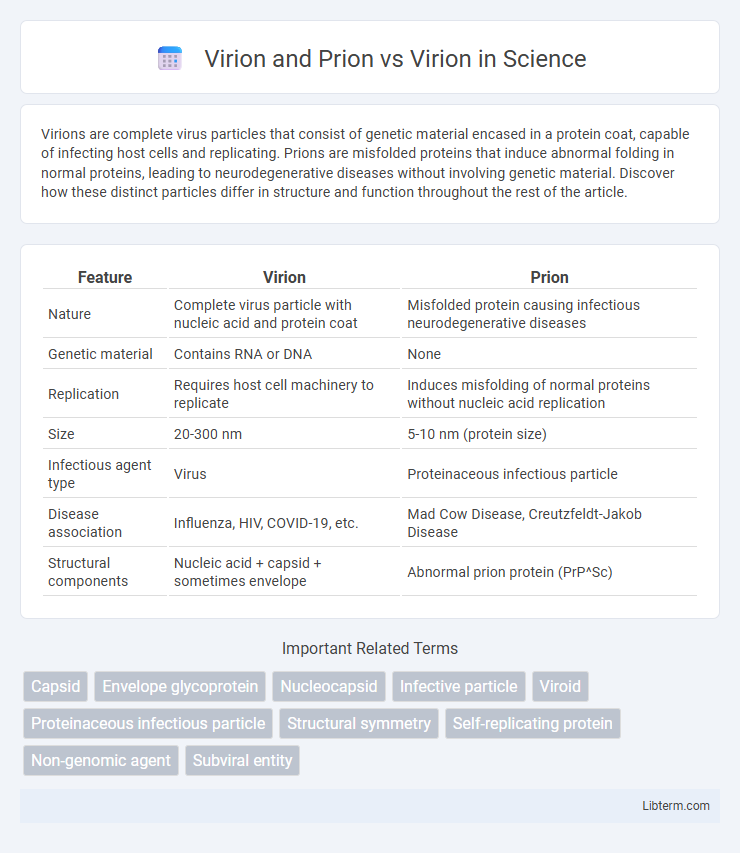Virions are complete virus particles that consist of genetic material encased in a protein coat, capable of infecting host cells and replicating. Prions are misfolded proteins that induce abnormal folding in normal proteins, leading to neurodegenerative diseases without involving genetic material. Discover how these distinct particles differ in structure and function throughout the rest of the article.
Table of Comparison
| Feature | Virion | Prion |
|---|---|---|
| Nature | Complete virus particle with nucleic acid and protein coat | Misfolded protein causing infectious neurodegenerative diseases |
| Genetic material | Contains RNA or DNA | None |
| Replication | Requires host cell machinery to replicate | Induces misfolding of normal proteins without nucleic acid replication |
| Size | 20-300 nm | 5-10 nm (protein size) |
| Infectious agent type | Virus | Proteinaceous infectious particle |
| Disease association | Influenza, HIV, COVID-19, etc. | Mad Cow Disease, Creutzfeldt-Jakob Disease |
| Structural components | Nucleic acid + capsid + sometimes envelope | Abnormal prion protein (PrP^Sc) |
Introduction to Virions and Prions
Virions are complete virus particles consisting of genetic material encased in a protein coat, capable of infecting host cells and replicating. Prions are infectious proteins that lack nucleic acids and propagate by inducing misfolding of normal proteins, leading to neurodegenerative diseases. Unlike virions, prions do not contain DNA or RNA, making them unique infectious agents with distinct mechanisms of transmission and pathology.
Defining Virions: Structure and Function
Virions are complete virus particles consisting of genetic material enclosed within a protective protein coat called a capsid, sometimes surrounded by a lipid envelope, facilitating infection of host cells. Their primary function is to deliver viral genomes into host cells to hijack cellular machinery for replication and propagation. Unlike prions, which are misfolded proteins causing neurodegenerative diseases without nucleic acids, virions contain nucleic acids essential for viral life cycles and infectivity.
What Are Prions? Characteristics and Mechanisms
Prions are infectious agents composed solely of misfolded proteins that induce abnormal folding in normal cellular proteins, primarily affecting the nervous system. Unlike virions, which contain genetic material enclosed in a protein coat for replication, prions lack nucleic acids and replicate by converting normal proteins into the pathogenic prion form, leading to neurodegenerative diseases like Creutzfeldt-Jakob disease. Their unique mechanism involves protein misfolding and aggregation, making prions resistant to conventional sterilization methods that typically inactivate virions.
Virion vs Prion: Fundamental Differences
Virions are complete virus particles consisting of genetic material encased in a protein coat, capable of infecting host cells and replicating, whereas prions are misfolded proteins that cause neurodegenerative diseases by inducing abnormal protein folding without containing nucleic acids. Virions exhibit a structured lifecycle involving attachment, penetration, replication, and release, contrasting with prions that propagate by converting normal proteins into disease-causing forms. The fundamental difference lies in virions being infectious agents with genetic information, while prions are infectious proteins lacking DNA or RNA.
Pathogenesis: How Virions and Prions Cause Disease
Virions, the complete infectious virus particles, cause disease by invading host cells and hijacking cellular machinery to replicate, often triggering immune responses and cellular damage. Prions are misfolded proteins that induce abnormal folding in normal prion proteins, leading to neurodegenerative diseases characterized by protein aggregation without nucleic acid involvement. The pathogenesis of virions involves direct viral replication and cytopathic effects, while prion diseases result from protein misfolding and accumulation causing neuronal death and spongiform encephalopathies.
Transmission Pathways: Virion vs Prion
Virions transmit through direct contact with infected bodily fluids, airborne droplets, or contaminated surfaces, enabling rapid spread of viral infections such as influenza and HIV. Prions, on the other hand, transmit primarily through ingestion of infected tissue, medical procedures involving contaminated instruments, or hereditary mutation, causing neurodegenerative diseases like Creutzfeldt-Jakob disease. Unlike virions, prion transmission lacks airborne or fluid-borne pathways, making transmission routes more limited but highly resistant to conventional sterilization methods.
Detection and Diagnosis of Virion- and Prion-Related Diseases
Detection and diagnosis of virion-related diseases often involve molecular techniques such as PCR, ELISA, and viral culture to identify viral nucleic acids, proteins, or infectious particles. Prion-related diseases require specialized assays like RT-QuIC and western blotting to detect misfolded prion proteins, as prions lack nucleic acids and cannot be identified via traditional viral detection methods. Accurate differentiation between virion and prion infections is critical, as treatment strategies and biosafety measures vary significantly.
Treatment Challenges: Managing Virion and Prion Infections
Treating virion infections often involves antiviral medications targeting specific viral replication mechanisms, whereas prion infections lack effective treatments due to the proteinaceous and highly resistant nature of prions. Virions, comprising nucleic acids encased in protein, can be neutralized by drugs or immune responses, while prions cause neurodegenerative disorders by inducing misfolded proteins without nucleic acids, complicating diagnosis and therapeutic intervention. Management of prion diseases focuses on supportive care and preventing disease transmission, as current strategies fail to halt prion propagation or reverse damage.
Prevention Strategies: Controlling Virion and Prion Spread
Effective prevention strategies for controlling virion spread include rigorous sanitation, vaccination programs, and use of antiviral agents that target viral replication. Prion transmission requires strict protocols such as sterilization of surgical instruments, avoiding consumption of contaminated tissue, and implementing animal feed regulations to prevent prion diseases. Both virion and prion control emphasize early detection, containment, and stringent hygiene practices to minimize infection risks.
Future Perspectives: Research and Innovation in Virion and Prion Studies
Ongoing research in virion and prion studies emphasizes molecular mechanisms and innovative diagnostic tools to enhance early detection and treatment strategies. Advances in nanotechnology and bioinformatics are fueling the development of targeted therapies and real-time monitoring systems for these infectious agents. Future perspectives highlight interdisciplinary collaboration to unravel their structural complexities, enabling precise interventions and improved public health outcomes.
Virion and Prion Infographic

 libterm.com
libterm.com